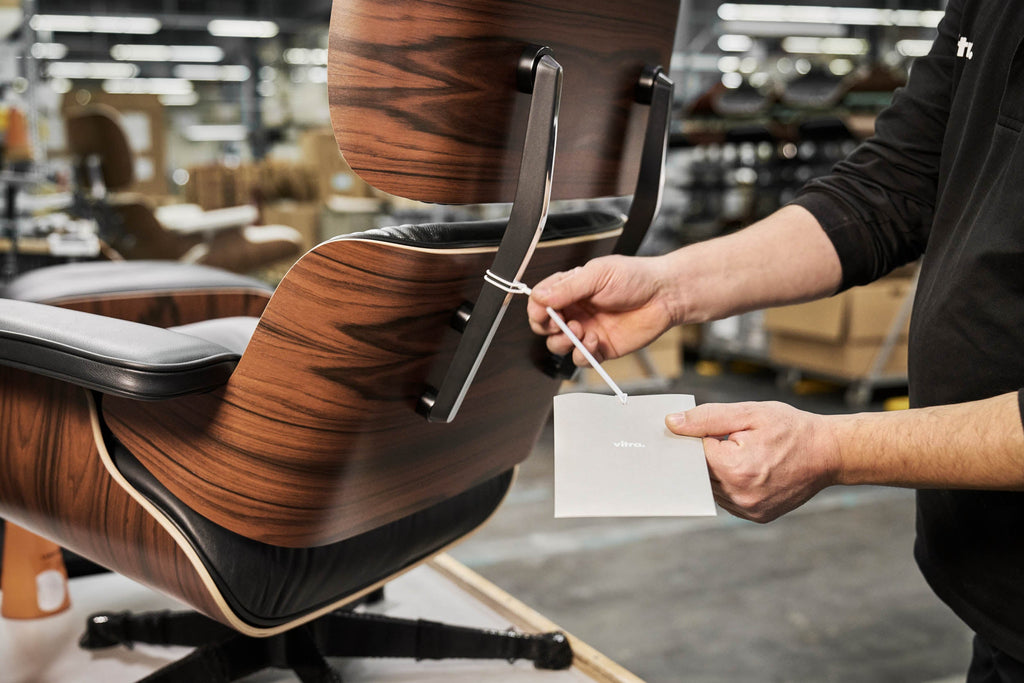What is an original?

An original is a piece produced by manufacturers authorized by the designer or his heirs. It is an object that has a value acquired by this relationship between manufacturer and designer, but also by its high material, aesthetic and functional quality. Read more about what an original is in the essay (in English) by Rolf Fehlbaum, former CEO of Vitra, which we published here:
When the pertinent legal and relational conditions are met, one can speak of an original design. This term means that a design – independent of its production date – was manufactured by the authorized manufacturer in the true spirit of the designer. These factors guarantee its authenticity. In the fine arts, it is clear what is meant by the terms "original" and "copy". With respect to the field of design, however, these words must be redefined.

↑ Original Lounge Chair at the Vitra factory
Reproduction is an intrinsic aspect of design logic. In the field of design, the most prevalent misunderstanding of the term "original" is that the only objects which deserve this designation are those that were manufactured during the earliest years of a design's production. According to this interpretation, a Corbusier armchair from the year 1928 or an Eames Plywood Chair produced in 1946 would be originals, while the same models by Le Corbusier or Charles und Ray Eames from current production would be copies, regardless of who the manufacturer is.
Copyists adhere to this notion. They admit that they are copying the original designs, but claim that the licensed manufacturers of classic designs – i.e. the companies who own the copyright (in the above examples, Cassina for Le Corbusier and Vitra for Eames) – do the same thing. In their view, the "originals" are the models from the earliest periods of production which are now found in museums and private collections, but not the present products by licensed manufacturers found in furniture stores.
This line of argument is faulty and misleading. Early examples of a design from the initial production phase are vintage objects. Rare and valuable, they are sought after by collectors because they represent the first expression of a new idea. Such vintage pieces are originals, but the products designed by Le Corbusier or the Eames and produced today by their legitimate manufacturers are also originals.

↑ The Lounge Chair has a Vitra nameplate
Why is this true? The intention of design is to solve a specific problem. Models from the early production phase represent an initial solution. Almost without exception, practical usage eventually reveals the need for improvements in specific aspects of a design. For the duration of their career, Charles and Ray Eames continued to develop and perfect their designs. The dimensions and materials of a product were changed, as well as individual parts (like glides, etc.), when better solutions were found. From this perspective, an early production model is worthy of admiration, but outdated and in some cases even obsolete.
The term "original", therefore, has nothing to do with the production date. The status of an original is determined by the relationship between the designer (or rightful heirs) and the manufacturer of the designer's products. There is not only a legal component to this relationship, but also an immaterial one based on shared ideals and mutual cooperation.

↑ The Lounge Chair is made from high-quality, durable materials
For any product to be designated as an "original", the originator of the design must have given the manufacturer the legal authorization to produce it. Anyone who produces a design without legal permission is appropriating property that belongs to someone else. This applies not only to the manufacturer, but also to the consumer who buys an unlicensed product.
Equally important is the transcendent, relational connection between the designer and manufacturer. It is evident in their close cooperation at every step of the production process. Because the plagiarist does not have this relationship, there is always uncertainty about the degree to which the copy deviates from the original idea, whether for reasons of ignorance, carelessness or cost reduction. The Original is by Vitra.
